The miracles that are called PH lamps – Part 2 – PH Floor lamps
Poul Henningsen (1894-1967), also known by the initials PH, was a Danish architect, film director, social critic and of course accomplished creator of lights. His fixation on lighting originated in his youth, when he grew up under the soft glow of petroleum lamps. Henningsen thought electric bulbs threw an impossible light, either it was too sharp or the lamp shades swallowed most of the light. Hence he wanted to develop a lamp that would have the same soft, relaxing qualities as petroleum lamps. The result of years of continuous and methodical attempts materialised in 1926: a three-shade lamp that later became widely known as the PH lamp.
-
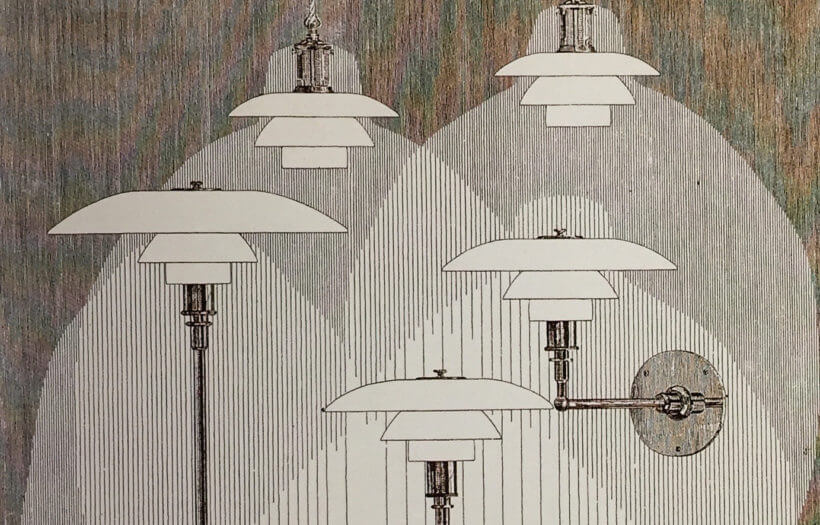 A selection of PH lamps drawn by Ib Andersen in 1927 (courtesy of Louis Poulsen – ‘Light Years Ahead’).
A selection of PH lamps drawn by Ib Andersen in 1927 (courtesy of Louis Poulsen – ‘Light Years Ahead’).
-
At the time of his death in 1967 Poul Henningsen had designed more than 100 lamps, of which Louis Poulsen nowadays still produces more than twenty. We would like to give you an impression of his amazing work, with a strong focus on his lesser-known designs. In this article, we will focus on his floor lamps, or in Danish: Standerlamper.
-
 Table, desk and floor lamps, Louis Poulsen catalogue B 50, 1953
(from the Palainco Archive).
Table, desk and floor lamps, Louis Poulsen catalogue B 50, 1953
(from the Palainco Archive).
-
Poul Henningsen developed a wide range of variations on the PH lamp’s principles. The lamps were made in standard production, but also upon special request. As we have already shown in two earlier contributions, Henningsen was exceedingly productive while the quality of the outcomes was outstanding. The only kind of lamp that lags behind a bit in quantity is the floor lamp. He only seems to have made seven versions in the standard range—for any other designer this would be a respectable amount, but for Poul Henningsen it’s a departure from his usual abundance of different designs.
-
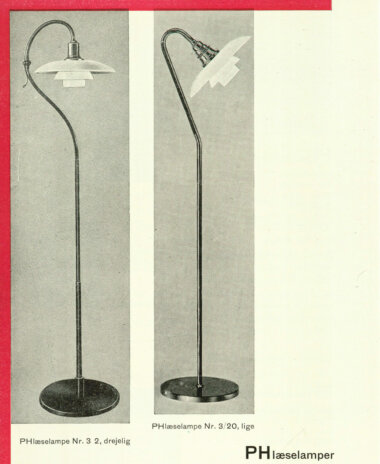 Four lamps from Louis Poulsen Catalogue 'Liste B 06' as published in 1936 (from the Palainco Archive)
Four lamps from Louis Poulsen Catalogue 'Liste B 06' as published in 1936 (from the Palainco Archive)
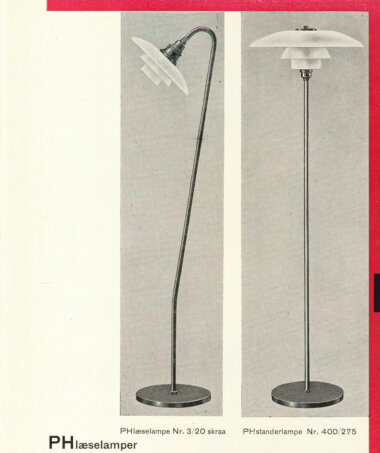
-
Looking at the two lamps in the middle, it seems to have been difficult to balance the three-shade part of the lamp with the foot on which it rests. To us, they seem differently proportioned than the others, and thus less elegantly balanced.
Fortunately, Henningsen managed to get the perfect shape with the adjustable reading lamp from 1931 that remained in the catalogue until 1939. For obvious reasons this lamp is also indicated as the question mark lamp (illustrated above, the one on the left and—as we like it so much—also below).
The article continues after the picture…
-
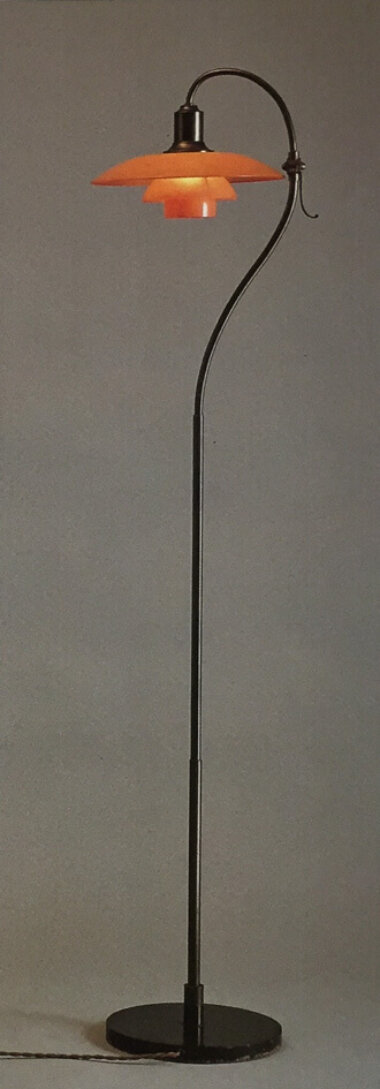 Adjustable reading lamp with 3/2 shades and frosted, patinated metal parts (courtesy of Louis Poulsen – ‘Light Years Ahead’; picture by Bent Ryberg).
Adjustable reading lamp with 3/2 shades and frosted, patinated metal parts (courtesy of Louis Poulsen – ‘Light Years Ahead’; picture by Bent Ryberg).
-
We found another remarkable example in Catalogue – El-Pe. With its characteristic appearance, this lamp was nicknamed ‘the Water Pump.’ In the first editions of this adjustable reading lamp the switch was mounted on the lever arm.
The catalogue of 1931 praised the lower power consumption of this lamp, which Louis Poulsen explained was possible as you could direct the floor lamp on the “book, newspaper or sewing” instead of using the general lighting of the room.
-
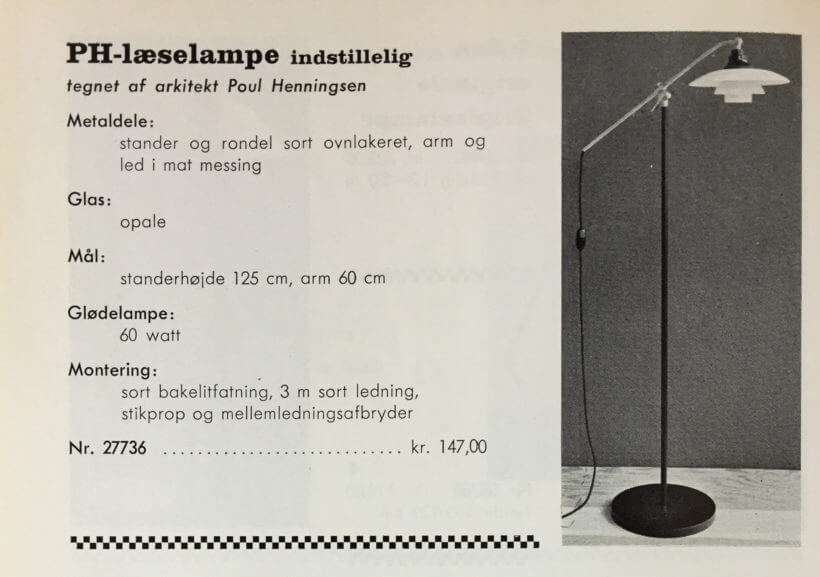 Reading lamp from 1957 with 3/2 shade of opal glass
(from the Palainco Archive, Louis Poulsen catalogue El-Pe).
Reading lamp from 1957 with 3/2 shade of opal glass
(from the Palainco Archive, Louis Poulsen catalogue El-Pe).
-
Towards the end of his life, Poul Henningsen had been working with plastics as a potential new material for his fixtures, instead of glass or metal. He intended to make a less expensive product, with the same lighting characteristics as glass.
However, it was not until the 1970s that plastic materials and work processes were developed to such a level that the lampshades could be made smooth, thus achieving the right quality. As a tribute to Poul Henningsen and his determined investigations, Louis Poulsen introduced a new floor lamp, the PH 80, on what would have been his 80th birthday.
-
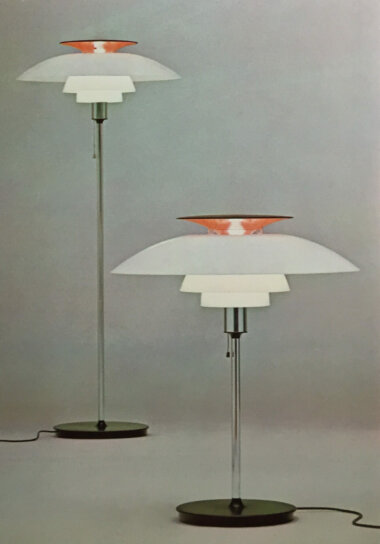 The PH 80 floor lamp, which has been in production since the early 1970s
(both pictures from a German Louis Poulsen catalogue from the 1970s, from the Palainco Archive).
The PH 80 floor lamp, which has been in production since the early 1970s
(both pictures from a German Louis Poulsen catalogue from the 1970s, from the Palainco Archive).
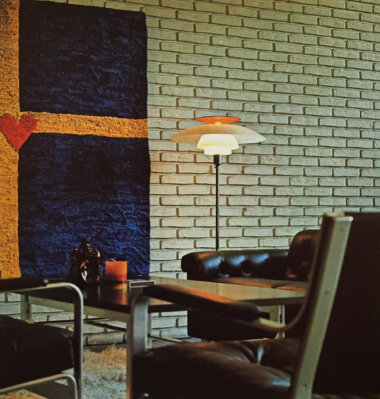
-
Officially, the lamp has been attributed to Bent Gantzel-Boysen, but we can probably all agree that he would not have been able to design this lamp without the earlier explorations of Poul Henningsen.
This is the second article in a series on the lesser-known PH lamps. In the other two articles, we showcased a selection of his wall and table lamps and in future editions we will reveal some amazing ceiling lamps.
If you would like to be the first to read articles on designers and special designs, please subscribe to our newsletter.
-
- Literature: Ove Hansen, Steen Jørgensen, Tina Jørstian, Poul Erik Munk Nielsen, Kurt Nørregaard, and Allen de Waal, Light Years Ahead: The Story of the PH Lamp, ed. by Tina Jørstian and Poul Erik Munk Nielsen (Copenhagen: Louis Poulsen, 1994).
Unless otherwise stated, all material is sourced and/or generated internally. All rights reserved.
- Text: Palainco, Koos Logger & Ingrid Stadler.
- Image sources: Courtesy of Louis Poulsen – ‘Light Years Ahead’, Bent Ryberg, Louis Poulsen - various catalogues from the Palainco Archive.
The article and its contents may not be copied or reproduced in any part or form without the prior written permission of the copyright holders.
Published on: 10 April 2017